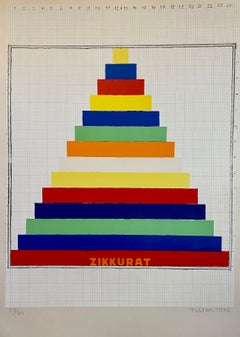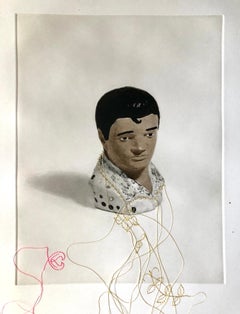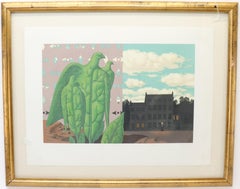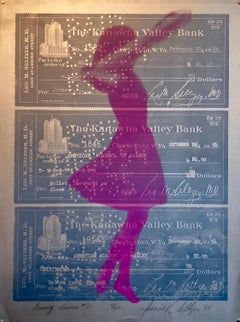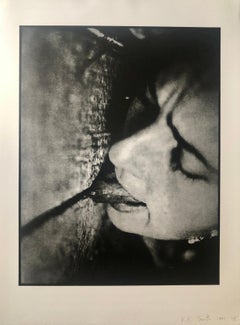Lions Gallery Figurative Prints
to
200
170
177
50
16
Overall Width
to
Overall Height
to
174
77
75
58
31
20
8
5
3
2
38
23
23
21
18
1
586
26
1
12
20
18
15
68
97
49
34
411
194
7
106
58
55
42
41
21
20
19
15
12
10
7
5
5
5
4
4
4
4
4
318
150
69
47
45
17
1
613
Vibrant 1975 Joe Tilson British Pop Art Screenprint, Woodblock, Colorful Print
By Joe Tilson
Located in Surfside, FL
Silkscreen screenprint. Hand signed and numbered. A pyramid or ziggurat in vibrant colors of blue, red, yellow, orange and green on heavy paper
Joseph Charles Tilson RA (born 24 Au...
Category
1970s Pop Art Abstract Prints
Materials
Screen
Latin American Mixed media Collage Photo Intaglio Gravure Print with Embroidery
By Liliana Porter
Located in Surfside, FL
Elvis:The Sewing Lesson (2011)
Mixed media intaglio print with embroidery, photogravure, thread, and collage on Magnani Pescia white paper.
edition of 100 plus 12 APs, 6 printers proofs, and 6 CCP archive proofs
17 ¾" x 13 ½" Published by Center for Contemporary Printmaking.
Elvis Presley, Rock & roll icon.
Liliana Porter (born 1941) is a contemporary artist working in a wide variety of media, including photography, printmaking, painting, drawing, installation, video, theater, and public art.
Porter was born in Buenos Aires, Argentina in 1941, but lives and works in New York. As a teenager, she attended the Universidad Iberoamericana in Mexico City, Mexico, where she studied under Guillermo Silva Santamaria and Mathias Goeritz. She returned to Argentina and completed her training at the Escuela Nacional de Bellas Artes in Buenos Aires. In 1964, she moved to New York City, where she co-founded the New York Graphic Workshop with fellow artists Luis Camnitzer and José Guillermo Castillo. In 1974 she was a co-founder and etching instructor at Studio Camnitzer, an artist's residence studio near Lucca, Italy that welcomes artists working in all media. After holding teaching positions at the Porter-Wiener Studio, the Printmaking Workshop, SUNY Purchase and State University of New York at Old Westbury, Porter became a professor at Queens College, City University of New York in 1991 and remained there until 2007.
Porter cites Luis Felipe Noe...
Category
2010s Conceptual Mixed Media
Materials
Thread, Intaglio, Photogravure
Surrealist Dream Lithograph Belgian Master Magritte Pencil Signed by Mourlot
By René Magritte
Located in Surfside, FL
Artist: Rene Magritte (after), Belgian (1898 - 1967)
Title: (from les Enfants Trouvés) Les Claires-Voies d'un Jeune Regard Embaument La Fête d'un Vieil Arbre
Year of original paintin...
Category
1960s Surrealist Landscape Prints
Materials
Lithograph
German Artist Impressionist Etching Judaica Jewish Sephardic Jewish Bezalel Era
By Hermann Struck
Located in Surfside, FL
Yemenite or Moroccan Sefardic rabbi portrait.
Framed 11 X 9 sight 6 X 4.5
Hermann Struck (6 March 1876 – 11 January 1944) was a German Jewish artist known for his etchings.
Hermann...
Category
Early 20th Century Impressionist Figurative Prints
Materials
Etching
1970s Pop Art "Dancing Lessons #2" Silver Silkscreen Mod Ballet Girl Print
By Joanne Seltzer
Located in Surfside, FL
Printed on a slightly reflective metallic silver finished paper. there is a companion piece on a money green paper. A depiction of a ballet dancer, superimposed upon canceled dance c...
Category
1970s American Modern Portrait Prints
Materials
Screen
Kiki Smith Offset Lithograph Photograph "My Secret Business" Photo Litho Print
By Kiki Smith
Located in Surfside, FL
My Secret Business, 1992-1993
Duotone offset litho, Lithograph
Sheet measures 30.13'' x 22.5'' (76 X 56 cm). 23 1/2 × 18 in (59.7 × 45.7 cm) image.
Hand-signed by artist, Signed, da...
Category
1990s Contemporary Figurative Prints
Materials
Photographic Film, Lithograph, Offset
Fernand Leger Colorful Modernist Drawing Limited Edition Serigraph Lithograph
By (after) Fernand Léger
Located in Surfside, FL
Serigraph, from ''Album of Ten Serigraphs'' (1954-55), by Fernand Leger (French 1881-1955), signed and dated in plate lower right, printed by Jean Bruller, distributed by Galerie Int...
Category
1950s Modern Abstract Prints
Materials
Lithograph
Lithuanian Artist Colored Lithograph Mother And Son - Boris Deutsch
By Boris Deutsch
Located in Surfside, FL
Boris deutsch was born in krasnagorka lithuania june 4 1892 died in los angeles 1978.Entered the polytechnic school in riga 1905.School of applied arts berlin 1912. Settled in l.A. 1...
Category
20th Century Modern Figurative Prints
Materials
Etching
Lithuanian Artist Colored Lithograph Mother And Son - Boris Deutsch
By Boris Deutsch
Located in Surfside, FL
Boris deutsch was born in krasnagorka lithuania june 4 1892 died in los angeles 1978.Entered the polytechnic school in riga 1905.School of applied arts berlin 1912. Settled in l.A. 1...
Category
20th Century Modern Figurative Prints
Materials
Etching
Lithuanian Artist Colored Lithograph Mother And Son - Boris Deutsch
By Boris Deutsch
Located in Surfside, FL
Boris deutsch was born in krasnagorka lithuania june 4 1892 died in los angeles 1978.Entered the polytechnic school in riga 1905.School of applied arts berlin 1912. Settled in l.A. 1...
Category
20th Century Modern Figurative Prints
Materials
Etching
Untitled Still Life Hanging Plaid Shirt, Figurative Poetry Lithograph
Located in Surfside, FL
Signed, numbered and dated limited edition lithograph print. The number might not match the photo as I had more than one.
George Schneeman (March 11, 1934 – January 27, 2009) was an...
Category
1980s American Modern Figurative Prints
Materials
Lithograph
Israeli Expressionist Yosl Bergner Modernist Lithograph
By Yosl Bergner
Located in Surfside, FL
Hand signed in Hebrew Lower right. Dimensions: H 19.5" x 13.5"
Bergner, Yosl (Vladimir Jossif) (b Vienna, 13 Oct 1920). surrealist, surrealism. belongs to the generation of people...
Category
Mid-20th Century Modern Figurative Prints
Materials
Lithograph
Israeli Expressionist Yosl Bergner Modernist Lithograph
By Yosl Bergner
Located in Surfside, FL
Hand signed in Hebrew Lower right. Dimensions: H 19.5" x 13.5"
Bergner, Yosl (Vladimir Jossif) (b Vienna, 13 Oct 1920). surrealist, surrealism. belongs to the generation of people...
Category
Mid-20th Century Modern Figurative Prints
Materials
Lithograph
Israeli Expressionist Yosl Bergner Modernist Lithograph
By Yosl Bergner
Located in Surfside, FL
Hand signed in Hebrew Lower right. Dimensions: H 19.5" x 13.5"
Bergner, Yosl (Vladimir Jossif) (b Vienna, 13 Oct 1920). surrealist, surrealism. belongs to the generation of people...
Category
Mid-20th Century Modern Figurative Prints
Materials
Lithograph
Early Israeli Russian Artist Lithograph With Woman Bezalel
By Miriam Hadgadya
Located in Surfside, FL
All but forgotten today, Had Gadya was the first woman to study at the Bezalel Art School and an outstanding painter in 1920s' Tel Aviv.
In 1912, she was 17 years old, the only fem...
Category
20th Century Modern Figurative Prints
Materials
Lithograph
Social Realist Original Lithograph Advertisement Moses Soyer
By Moses Soyer
Located in Surfside, FL
Moses Soyer (December 25, 1899 – September 3, 1974) was an American social realist painter. Soyer was born in Borisoglebsk, Russian Empire, in 1899. His father was a Hebrew scholar, ...
Category
Mid-20th Century American Realist Figurative Prints
Materials
Lithograph
Large Silkscreen Serigraph Neo Figurative Expressionist Print Jorg Immendorff
By Jörg Immendorf
Located in Surfside, FL
Jorg Immendorff (German, 1945-2007)
Untitled, Germany, 2006
serigraph
hand signed and dated lower right margin, numbered 20/27 lower left
framed
74.5 x 48.75 inches (sight).
82.25 x 55.5 inches (frame).
This work is number 20 from the edition of 27.
Provenance: T. Kreuzer Gallery, Cologne, Friedman Benda Gallery, New York City
Jörg Immendorff (1945–2007) was a German painter, sculptor, stage designer and art professor. He was a member of the art movement Neue Wilde. He worked as a painter, sculpture and print maker in steel, bronze, oil painting, lithography etching and serigraphy.
Immendorff was born in Bleckede, Lower Saxony, near Lüneburg on the west bank of the Elbe. He attended the boarding School Ernst-Kalkuhl Gymnasium as a student. At the age of sixteen he had his first exhibition in a jazz hall cellar in Bonn.
Beginning in 1963, Immendorff studied at the Art Academy in Düsseldorf (Kunstakademie Düsseldorf). Initially he studied for three terms with the theater designer Teo Otto. After Otto threw him out of his class for refusing to let one of his paintings serve as stage-set decoration, Immendorff was accepted as a student by Joseph Beuys. The academy expelled him because of some of his (left-wing) political activities and neo-dada actions.
From 1969 to 1980, Immendorff worked as an art teacher at a public school, and then as a free artist, holding visiting professorships all over Europe. In 1989, he became professor at the Städelschule in Frankfurt am Main and in 1996 he became professor at the Art Academy in Düsseldorf—the same school that had dismissed him decades earlier as a student.
Jörg Immendorff often worked in "grand cycles of paintings" that often lasted years at a time and were political in nature. Notable cycles include LIDL, Maoist Paintings, Cafè Deutschland , and The Rake's Progress. The first body of work that Immendorff gave a name to were his LIDL paintings, sculptures, performances, and documents, that he executed during 1968-1970. The name, "LIDL" was inspired by the sound of a child's rattle makes and much of his work from this period included the iconography of new beginnings and innocence. LIDL is comparable to Dadaist but unlike the Dada movement it never became an established group but rather consisted of a variety of artists (including James Lee Byars, Marcel Broodthaers, Nam June Paik, and Joseph Beuys) participating in actions and activities.
In January 1968 he appeared in front of the West German Parliament in Bonn with a wood block labeled “Lidl” tethered to his ankle and painted in the colors of the German flag; he was subsequently arrested for defaming the flag.
Best known is his Cafe Deutschland series of sixteen large paintings (1977–1984) that were inspired by Renato Guttuso Caffè Greco; in these crowded colorful pictures, Immendorff had disco-goers symbolize the conflict between East and West Germany. Since the 1970s, he worked closely with the painter A. R. Penck from Dresden (in East Germany).
Immendorff created several stage designs, including two for the Salzburg Theater Festival. He designed sets for the operas Elektra and The Rake's Progress. The latter also inspired a series of paintings in which he cast himself as the rake.
In 1984, Immendorff opened the bar La Paloma near the Reeperbahn in Hamburg St. Pauli and created a large bronze sculpture of Hans Albers there. He also contributed to the design of Andre Heller's avant-garde amusement park "Luna, Luna" in 1987. Immendorff created various sculptures; one spectacular example is a 25 m tall iron sculpture in the form of an oak tree trunk, erected in Riesa in 1999. In 2006, Immendorff selected 25 of his paintings for an illustrated Bible. In the foreword he described his belief in God.
A major 2019 survey began at the Haus der Kunst in Munich and later traveled later to the Museo Reina Sofía in Madrid and the Fondazione Querini Stampalia in Venice, curated by Francesco Bonami. In 2000, Immendorff married his former student Oda Jaune. The have one daughter Ida Immendorff. He was a member of the Junge Wilde (German for "young wild ones")
In 1978, the Junge Wilde painting style arose in the German-speaking world in opposition to established avant garde, minimal art and conceptual art. It was linked to the similar Transavanguardia movement in Italy, USA (neo-expressionism) and France (Figuration Libre). The Junge Wilde painted their expressive paintings in bright, intense colors and with quick, broad brushstrokes very much influenced by Professor at the Academy of Art in Berlin, Karl Horst Hödicke (b:1938). They were sometimes called the Neue Wilde. Berlin: Luciano...
Category
Early 2000s Neo-Expressionist Abstract Prints
Materials
Screen
American Abstract Color Monotype Painting Tar Cart #2 Joseph Solman WPA Artist
By Joseph Solman
Located in Surfside, FL
"Tar Cart #2" by Joseph Solman (American, 1909-2008)
Hand signed recto
Joseph Solman (January 25, 1909 – April 16, 2008) was a Jewish American painter, a founder of The Ten, a group...
Category
20th Century American Modern Figurative Paintings
Materials
Monotype
Rare Salvador Dali Surrealist 3D Pop Up Etching Engraving Paper Sculpture 1973
By Salvador Dalí
Located in Surfside, FL
Genre: Surrealism
Subject: people, architecture rendering
Medium: Etching
Surface: Paper
Salvador Dali (Spanish, 1904-1989) I believe the title is L'Immortalite de L'Imperialisme Ge...
Category
1970s Surrealist Figurative Prints
Materials
Paper, Board, Etching
Lithograph Italian Post Modernist Figurative Pop Art
By Sandro Chia
Located in Surfside, FL
Sandro Chia was born in Florence in 1946. He has studied at the Istituto d’Arte and then at the Accademia di Belle Arti in Florence where he graduated in 1969. After graduation, he h...
Category
Late 20th Century Pop Art Figurative Prints
Materials
Lithograph
Lithograph Italian Post Modernist Figurative Pop Art
By Sandro Chia
Located in Surfside, FL
Sandro Chia was born in Florence in 1946. He has studied at the Istituto d’Arte and then at the Accademia di Belle Arti in Florence where he graduated in 1969. After graduation, he h...
Category
Late 20th Century Pop Art Figurative Prints
Materials
Lithograph
Abel Pann Israeli Bezalel School Lithograph Judaica Biblical Print Jewish Art
By Abel Pann
Located in Surfside, FL
Abel Pann (1883–1963) was a European Jewish painter who settled in the Talpiot neighborhood of Jerusalem in the early twentieth century and taught at the Bezalel Academy of Art under...
Category
Mid-20th Century Symbolist Figurative Prints
Materials
Lithograph
Abel Pann Israeli Bezalel School Lithograph Judaica Biblical Print Jewish Art
By Abel Pann
Located in Surfside, FL
Abel Pann (1883–1963) was a European Jewish painter who settled in the Talpiot neighborhood of Jerusalem in the early twentieth century and taught at the Bezalel Academy of Art under...
Category
Mid-20th Century Symbolist Figurative Prints
Materials
Lithograph
Abel Pann Israeli Bezalel School Lithograph Judaica Biblical Print Jewish Art
By Abel Pann
Located in Surfside, FL
Abel Pann (1883–1963) was a European Jewish painter who settled in the Talpiot neighborhood of Jerusalem in the early twentieth century and taught at the Bezalel Academy of Art under...
Category
Mid-20th Century Symbolist Figurative Prints
Materials
Lithograph
Abel Pann Israeli Bezalel School Lithograph Judaica Biblical Print Jewish Art
By Abel Pann
Located in Surfside, FL
Abel Pann (1883–1963) was a European Jewish painter who settled in the Talpiot neighborhood of Jerusalem in the early twentieth century and taught at the Bezalel Academy of Art under...
Category
Mid-20th Century Symbolist Figurative Prints
Materials
Lithograph
Abel Pann Israeli Bezalel School Lithograph Judaica Biblical Print Jewish Art
By Abel Pann
Located in Surfside, FL
Abel Pann (1883–1963) was a European Jewish painter who settled in the Talpiot neighborhood of Jerusalem in the early twentieth century and taught at the Bezalel Academy of Art under...
Category
Mid-20th Century Symbolist Figurative Prints
Materials
Lithograph
Abel Pann Israeli Bezalel School Lithograph Judaica Biblical Print Jewish Art
By Abel Pann
Located in Surfside, FL
Abel Pann (1883–1963) was a European Jewish painter who settled in the Talpiot neighborhood of Jerusalem in the early twentieth century and taught at the Bezalel Academy of Art under...
Category
Mid-20th Century Symbolist Figurative Prints
Materials
Lithograph
Abel Pann Israeli Bezalel School Lithograph Judaica Biblical Print Jewish Art
By Abel Pann
Located in Surfside, FL
Abel Pann (1883–1963) was a European Jewish painter who settled in the Talpiot neighborhood of Jerusalem in the early twentieth century and taught at the Bezalel Academy of Art under...
Category
Mid-20th Century Symbolist Figurative Prints
Materials
Lithograph
Abel Pann Israeli Bezalel School Lithograph Judaica Biblical Print Jewish Art
By Abel Pann
Located in Surfside, FL
Abel Pann (1883–1963) was a European Jewish painter who settled in the Talpiot neighborhood of Jerusalem in the early twentieth century and taught at the Bezalel Academy of Art under...
Category
Mid-20th Century Symbolist Figurative Prints
Materials
Lithograph
Abel Pann Israeli Bezalel School Lithograph Judaica Biblical Print Jewish Art
By Abel Pann
Located in Surfside, FL
Abel Pann (1883–1963) was a European Jewish painter who settled in the Talpiot neighborhood of Jerusalem in the early twentieth century and taught at the Bezalel Academy of Art under...
Category
Mid-20th Century Symbolist Figurative Prints
Materials
Lithograph
Abel Pann Israeli Bezalel School Lithograph Judaica Biblical Print Jewish Art
By Abel Pann
Located in Surfside, FL
Abel Pann (1883–1963) was a European Jewish painter who settled in the Talpiot neighborhood of Jerusalem in the early twentieth century and taught at the Bezalel Academy of Art under...
Category
Mid-20th Century Symbolist Figurative Prints
Materials
Lithograph
Abel Pann Israeli Bezalel School Lithograph Judaica Biblical Print Jewish Art
By Abel Pann
Located in Surfside, FL
Abel Pann (1883–1963) was a European Jewish painter who settled in the Talpiot neighborhood of Jerusalem in the early twentieth century and taught at the Bezalel Academy of Art under...
Category
Mid-20th Century Symbolist Figurative Prints
Materials
Lithograph
Abel Pann Israeli Bezalel School Lithograph Judaica Biblical Print Jewish Art
By Abel Pann
Located in Surfside, FL
Abel Pann (1883–1963) was a European Jewish painter who settled in the Talpiot neighborhood of Jerusalem in the early twentieth century and taught at the Bezalel Academy of Art under...
Category
Mid-20th Century Symbolist Figurative Prints
Materials
Lithograph
Abel Pann Israeli Bezalel School Lithograph Judaica Biblical Print Jewish Art
By Abel Pann
Located in Surfside, FL
Abel Pann (1883–1963) was a European Jewish painter who settled in the Talpiot neighborhood of Jerusalem in the early twentieth century and taught at the Bezalel Academy of Art under...
Category
Mid-20th Century Symbolist Figurative Prints
Materials
Lithograph
Abel Pann Israeli Bezalel School Lithograph Judaica Biblical Print Jewish Art
By Abel Pann
Located in Surfside, FL
Abel Pann (1883–1963) was a European Jewish painter who settled in the Talpiot neighborhood of Jerusalem in the early twentieth century and taught at the Bezalel Academy of Art under...
Category
Mid-20th Century Symbolist Figurative Prints
Materials
Lithograph
Abel Pann Israeli Bezalel School Lithograph Judaica Biblical Print Jewish Art
By Abel Pann
Located in Surfside, FL
Abel Pann (1883–1963) was a European Jewish painter who settled in the Talpiot neighborhood of Jerusalem in the early twentieth century and taught at the Bezalel Academy of Art under...
Category
Mid-20th Century Symbolist Figurative Prints
Materials
Lithograph
Abel Pann Israeli Bezalel School Lithograph Judaica Biblical Print Jewish Art
By Abel Pann
Located in Surfside, FL
Abel Pann (1883–1963) was a European Jewish painter who settled in the Talpiot neighborhood of Jerusalem in the early twentieth century and taught at the Bezalel Academy of Art under...
Category
Mid-20th Century Symbolist Figurative Prints
Materials
Lithograph
Abel Pann Israeli Bezalel School Lithograph Judaica Biblical Print Jewish Art
By Abel Pann
Located in Surfside, FL
Abel Pann (1883–1963) was a European Jewish painter who settled in the Talpiot neighborhood of Jerusalem in the early twentieth century and taught at the Bezalel Academy of Art under...
Category
Mid-20th Century Symbolist Figurative Prints
Materials
Lithograph
Abel Pann Israeli Bezalel School Lithograph Judaica Biblical Print Jewish Art
By Abel Pann
Located in Surfside, FL
Abel Pann (1883–1963) was a European Jewish painter who settled in the Talpiot neighborhood of Jerusalem in the early twentieth century and taught at the Bezalel Academy of Art under...
Category
Mid-20th Century Symbolist Figurative Prints
Materials
Lithograph
Abel Pann Israeli Bezalel School Lithograph Judaica Biblical Print Jewish Art
By Abel Pann
Located in Surfside, FL
Abel Pann (1883–1963) was a European Jewish painter who settled in the Talpiot neighborhood of Jerusalem in the early twentieth century and taught at the Bezalel Academy of Art under...
Category
Mid-20th Century Symbolist Figurative Prints
Materials
Lithograph
Abel Pann Israeli Bezalel School Lithograph Judaica Biblical Print Jewish Art
By Abel Pann
Located in Surfside, FL
Abel Pann (1883–1963) was a European Jewish painter who settled in the Talpiot neighborhood of Jerusalem in the early twentieth century and taught at the Bezalel Academy of Art under...
Category
Mid-20th Century Symbolist Figurative Prints
Materials
Lithograph
Abel Pann Israeli Bezalel School Lithograph Judaica Biblical Print Jewish Art
By Abel Pann
Located in Surfside, FL
Abel Pann (1883–1963) was a European Jewish painter who settled in the Talpiot neighborhood of Jerusalem in the early twentieth century and taught at the Bezalel Academy of Art under...
Category
Mid-20th Century Symbolist Figurative Prints
Materials
Lithograph
Abel Pann Israeli Bezalel School Lithograph Judaica Biblical Print Jewish Art
By Abel Pann
Located in Surfside, FL
Abel Pann (1883–1963) was a European Jewish painter who settled in the Talpiot neighborhood of Jerusalem in the early twentieth century and taught at the Bezalel Academy of Art under...
Category
Mid-20th Century Symbolist Figurative Prints
Materials
Lithograph
Abel Pann Israeli Bezalel School Lithograph Judaica Biblical Print Jewish Art
By Abel Pann
Located in Surfside, FL
Abel Pann (1883–1963) was a European Jewish painter who settled in the Talpiot neighborhood of Jerusalem in the early twentieth century and taught at the Bezalel Academy of Art under...
Category
Mid-20th Century Symbolist Figurative Prints
Materials
Lithograph
Abel Pann Israeli Bezalel School Lithograph Judaica Biblical Print Jewish Art
By Abel Pann
Located in Surfside, FL
Abel Pann (1883–1963) was a European Jewish painter who settled in the Talpiot neighborhood of Jerusalem in the early twentieth century and taught at the Bezalel Academy of Art under...
Category
Mid-20th Century Symbolist Figurative Prints
Materials
Lithograph
Abel Pann Israeli Bezalel School Lithograph Judaica Biblical Print Jewish Art
By Abel Pann
Located in Surfside, FL
Abel Pann (1883–1963) was a European Jewish painter who settled in the Talpiot neighborhood of Jerusalem in the early twentieth century and taught at the Bezalel Academy of Art under...
Category
Mid-20th Century Symbolist Figurative Prints
Materials
Lithograph
Abel Pann Israeli Bezalel School Lithograph Judaica Biblical Print Jewish Art
By Abel Pann
Located in Surfside, FL
Abel Pann (1883–1963) was a European Jewish painter who settled in the Talpiot neighborhood of Jerusalem in the early twentieth century and taught at the Bezalel Academy of Art under...
Category
Mid-20th Century Symbolist Figurative Prints
Materials
Lithograph
Abel Pann Israeli Bezalel School Lithograph Judaica Biblical Print Jewish Art
By Abel Pann
Located in Surfside, FL
Abel Pann (1883–1963) was a European Jewish painter who settled in the Talpiot neighborhood of Jerusalem in the early twentieth century and taught at the Bezalel Academy of Art under...
Category
Mid-20th Century Symbolist Figurative Prints
Materials
Lithograph
Abel Pann Israeli Bezalel School Lithograph Judaica Biblical Print Jewish Art
By Abel Pann
Located in Surfside, FL
Abel Pann (1883–1963) was a European Jewish painter who settled in the Talpiot neighborhood of Jerusalem in the early twentieth century and taught at the Bezalel Academy of Art under...
Category
Mid-20th Century Symbolist Figurative Prints
Materials
Lithograph
Abel Pann Israeli Bezalel School Lithograph Judaica Biblical Print Jewish Art
By Abel Pann
Located in Surfside, FL
Abel Pann (1883–1963) was a European Jewish painter who settled in the Talpiot neighborhood of Jerusalem in the early twentieth century and taught at the Bezalel Academy of Art under...
Category
Mid-20th Century Symbolist Figurative Prints
Materials
Lithograph
Abel Pann Israeli Bezalel School Lithograph Judaica Biblical Print Jewish Art
By Abel Pann
Located in Surfside, FL
Abel Pann (1883–1963) was a European Jewish painter who settled in the Talpiot neighborhood of Jerusalem in the early twentieth century and taught at the Bezalel Academy of Art under...
Category
Mid-20th Century Symbolist Figurative Prints
Materials
Lithograph
Abel Pann Israeli Bezalel School Lithograph Judaica Biblical Print Jewish Art
By Abel Pann
Located in Surfside, FL
Abel Pann (1883–1963) was a European Jewish painter who settled in the Talpiot neighborhood of Jerusalem in the early twentieth century and taught at the Bezalel Academy of Art under...
Category
Mid-20th Century Symbolist Figurative Prints
Materials
Lithograph
Abel Pann Israeli Bezalel School Lithograph Judaica Biblical Print Jewish Art
By Abel Pann
Located in Surfside, FL
Abel Pann (1883–1963) was a European Jewish painter who settled in the Talpiot neighborhood of Jerusalem in the early twentieth century and taught at the Bezalel Academy of Art under...
Category
Mid-20th Century Symbolist Figurative Prints
Materials
Lithograph
Abel Pann Israeli Bezalel School Lithograph Judaica Biblical Print Jewish Art
By Abel Pann
Located in Surfside, FL
Abel Pann (1883–1963) was a European Jewish painter who settled in the Talpiot neighborhood of Jerusalem in the early twentieth century and taught at the Bezalel Academy of Art under...
Category
Mid-20th Century Symbolist Figurative Prints
Materials
Lithograph
Abel Pann Israeli Bezalel School Lithograph Judaica Biblical Print Jewish Art
By Abel Pann
Located in Surfside, FL
Abel Pann (1883–1963) was a European Jewish painter who settled in the Talpiot neighborhood of Jerusalem in the early twentieth century and taught at the Bezalel Academy of Art under...
Category
Mid-20th Century Symbolist Figurative Prints
Materials
Lithograph
Abel Pann Israeli Bezalel School Lithograph Judaica Biblical Print Jewish Art
By Abel Pann
Located in Surfside, FL
Abel Pann (1883–1963) was a European Jewish painter who settled in the Talpiot neighborhood of Jerusalem in the early twentieth century and taught at the Bezalel Academy of Art under...
Category
Mid-20th Century Symbolist Figurative Prints
Materials
Lithograph
Abel Pann Israeli Bezalel School Lithograph Judaica Biblical Print Jewish Art
By Abel Pann
Located in Surfside, FL
Abel Pann (1883–1963) was a European Jewish painter who settled in the Talpiot neighborhood of Jerusalem in the early twentieth century and taught at the Bezalel Academy of Art under...
Category
Mid-20th Century Symbolist Figurative Prints
Materials
Lithograph
Abel Pann Israeli Bezalel School Lithograph Judaica Biblical Print Jewish Art
By Abel Pann
Located in Surfside, FL
Abel Pann (1883–1963) was a European Jewish painter who settled in the Talpiot neighborhood of Jerusalem in the early twentieth century and taught at the Bezalel Academy of Art under...
Category
Mid-20th Century Symbolist Figurative Prints
Materials
Lithograph
Simka Simkhovitch WPA Artist Lithograph Island Beach 1933 American Modernist
By Simka Simkhovitch
Located in Surfside, FL
Simka Simkhovitch (Russian/American 1893 - 1949) signed lithograph. Pencil signed and dated "S. Simkhovitch 1933" lower center. Title "Island Beach,"...
Category
1930s American Modern Landscape Prints
Materials
Lithograph
Abel Pann Israeli Bezalel School Lithograph Judaica Biblical Print Jewish Art
By Abel Pann
Located in Surfside, FL
Abel Pann (1883–1963) was a European Jewish painter who settled in the Talpiot neighborhood of Jerusalem in the early twentieth century and taught at the Bezalel Academy of Art under...
Category
Mid-20th Century Symbolist Figurative Prints
Materials
Lithograph
